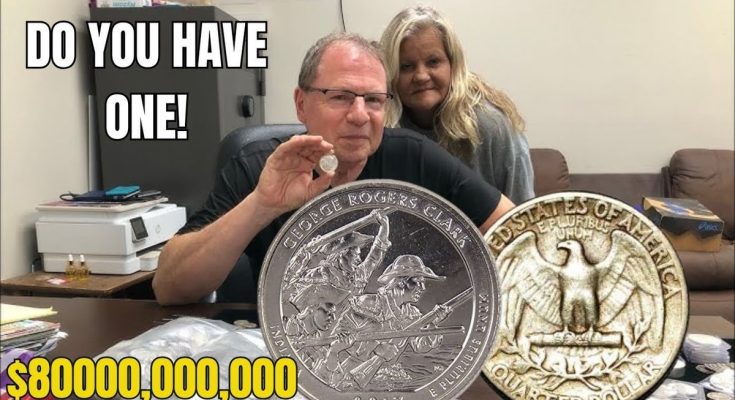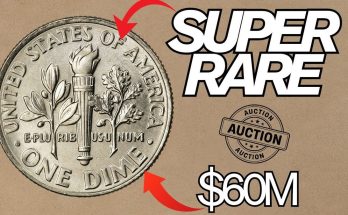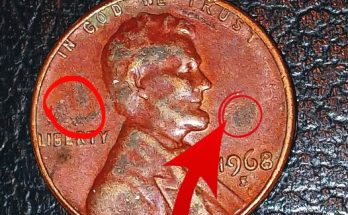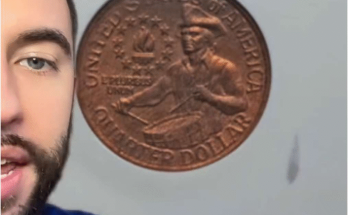The quarter—that everyday, 25-cent workhorse of American currency—is often the most overlooked coin in your pocket change. Yet, the history of the Washington Quarter series, from its silver origins in 1932 to the modern clad issues, is riddled with incredible stories of minting mishaps and condition rarities that have turned ordinary coins into five-figure windfalls. The image before you represents the ultimate coin collector’s dream: the discovery of a seemingly common quarter that is, in fact, an extremely rare and valuable treasure.
While most circulated quarters are worth face value, a select few, especially those with certain errors or in flawless condition, are in a class all their own. The caption, “Rare Washington Quarters That Could Make You Rich Overnight!” is not hyperbole for these legendary coins; it’s a documented reality for error varieties that fetch incredible prices at auction.
The Power of the Minting Error
The biggest jackpots in modern numismatics are often found in coins that were never supposed to exist—minting errors. These are the flaws that arise from imperfections in the production process and include:
- Doubled Die Errors (DDO/DDR): These are the most famous and highly sought-after errors, occurring when the coin die receives a slightly misaligned second impression from the hub, resulting in a distinct, visible doubling of the letters or design elements. Key examples include the 1937-P Doubled Die Obverse (DDO), which can be worth up to $13,500 in high grades, and the 1942-D Doubled Die Obverse, valued up to $7,300.
- Over Mint Mark (OMM) Errors: Before 1990, mint marks were hand-punched onto the dies. If one mint mark was accidentally punched over another—such as a “D” over an “S” or an “S” over a “D”—the resulting “Over Mint Mark” coin is extremely valuable. A 1950-D over S quarter, for instance, has commanded prices up to $3,300.
- Struck on the Wrong Planchet: Some of the most dramatic errors occur when a quarter planchet (the blank disc of metal) is accidentally struck using the dies for a different coin, or a different coin’s planchet is used for a quarter. Examples of a Washington Quarter struck on a dime planchet have sold for hundreds, and sometimes thousands, of dollars.
Modern Miracles: The Value of Perfection
While the older, silver Washington Quarters (1932-1964) have a floor value based on their 90% silver content, the modern, copper-nickel clad quarters (1965-Present) derive their extreme value almost entirely from two factors: rarity in perfect condition and specific, low-mintage commemorative errors.
Coins that survive decades in pristine, “Mint State” condition are profoundly scarce. The difference between a quarter in circulated condition and one certified as MS-68 (Mint State 68, near-perfect) can be thousands of dollars.
- The 1966 Quarter: A common year, but a single, near-perfect 1966 Washington Quarter (PCGS MS68+) holds an auction record of $21,000.
- The 1968 Quarter: Likewise, a 1968 Quarter without a mint mark in the flawless MS-68 grade has been sold for up to $4,000+, while the regular circulating versions are worth less than a dollar. The auction record for a 1968 quarter is $9,400 for an MS68 specimen.
- The State Quarter and ATB Program: Even the State Quarters and America the Beautiful (ATB) series have their hidden gems. The 2004-D Wisconsin Quarter with an “Extra Low Leaf” error has an auction record of $6,000. The ultra-rare 2019-W San Antonio Missions Quarter, with the special “W” mint mark from the West Point Mint, has hit a record of $75,000 in top grade!
How to Check Your Change
Before you dismiss the quarters in your jar, you must learn to look closer. Grab a magnifying glass and check for:
- Date and Mint Mark: Pay extra attention to the 1930s-1950s for silver issues, the 1960s-1980s for high-grade clad coins, and the 1999-Present for State Quarter and ATB errors.
- Doubling: Examine the date, “LIBERTY,” and “IN GOD WE TRUST” for a distinct, shelf-like doubling.
- Flawless Surface: Any coin with original, cartwheel-like luster and no scratches or dings is worth investigating further, as condition dictates value for modern coins.
The message is clear: your next financial breakthrough might be hidden in the bottom of your coin jar. Start searching now!



